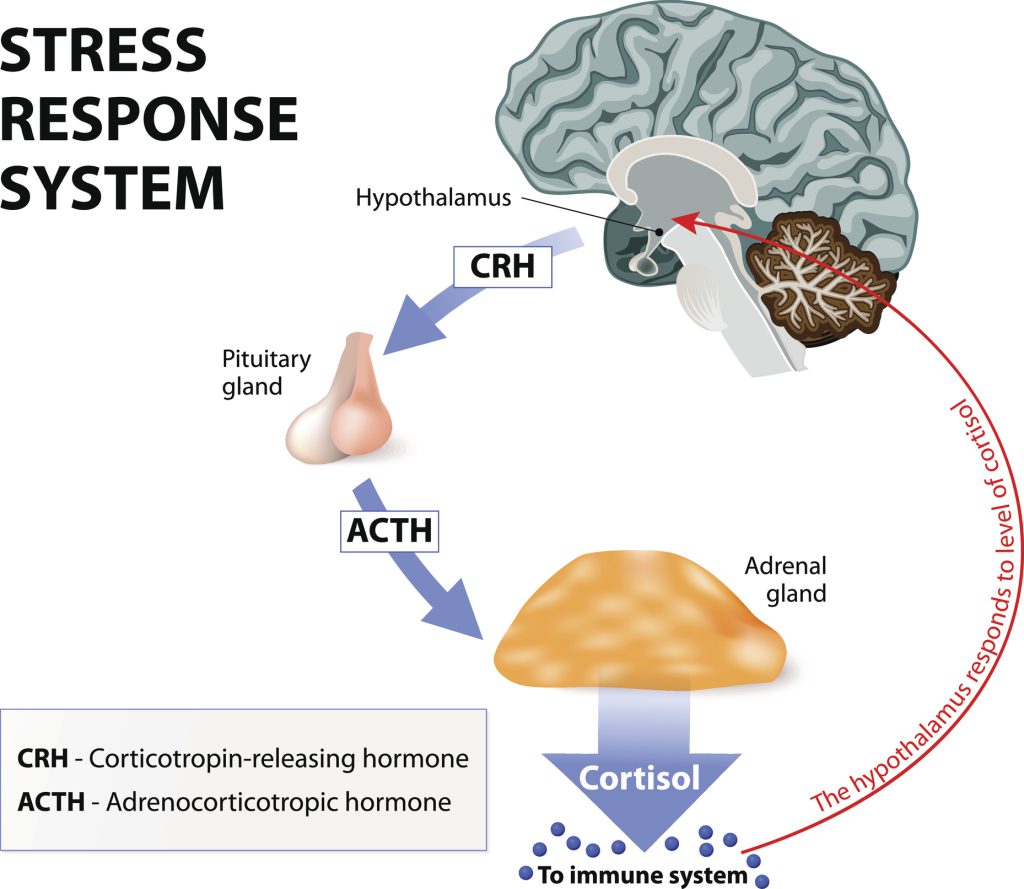As it was Mental Health Awareness Week last week, this week’s blog post will highlight the importance of understanding the impact of stress from a neuroscientific perspective and discuss tips on how to reduce stress.
Stress is normal and a part of everyday life. Some stress is ‘good stress’ (such as what we feel when we are studying for an upcoming exam), as it can build stronger circuitry and resilience in the brain. However, there are two main types of stress that can negatively affect us: acute stress (short term) and chronic stress (long term).
Stress can affect the brain in a number of ways. The sympathetic nervous system (SNS) activates the ‘fight-or-flight’ system in our brain when we experience acute stress. The hippocampus plays an important role in regulating emotions and memory and is known to shrink under long periods of stress causing impairments to memory and attention (Kaufer et al., 2014). The stress response in the brain begins in the amygdala which then activates the hypothalamic-pituitary-adrenalcortical (HPA) axis (consisting of the hypothalamus, pituitary gland and the adrenal cortex). The amygdala is primarily associated with emotion processing. The hypothalamus communicates with the rest of the body through the autonomic nervous system to regulate main bodily functions. The hypothalamus also releases a hormone, the corticotropin-releasing hormone which triggers the pituitary gland to release another hormone, the adrenocorticotropic hormone. The adrenocorticotropic hormone produced in the pituitary gland has an essential role in stimulating the adrenal gland to release cortisol so the body’s stress response can be regulated as well as reduce inflammation.
Research suggests that recurrent activation of the SNS and the HPA axis resulting from stress can lead to an increase in inflammation, which can influence the development of a variety of diseases (Muscatell & Eisenberger, 2012). Chronic stress results in the ‘fight-or-flight’ system being constantly amped up which can lead to sleep and digestive issues, a weakened immune system, neurodegeneration and hypertension.
“Because stress changes the way the brain’s neurons communicate with each other, chronic stress can cause our brains, nervous systems, and our behaviour to adjust to a vigilant and reactive state.”
- Bruce McEwen, neuroscientist from Rockefeller University
Our brains are composed of two types of tissue: grey matter (40% of the brain) and white matter (60%). Grey matter is found in the outermost layer of the brain and mainly processes and interprets information. Alternatively white matter is found beneath the grey matter and consists of myelinated axons with the role of transmitting signals to other parts of the central nervous system (CNS). Chronic stress can lead to changes in brain structure and connectivity. For example, individuals that have experienced post-traumatic stress disorder (PTSD) have differences in grey matter volume compared to white matter volume alongside changes in the size and connectivity of the amygdala. Furthermore, Kaufer et al., (2014) discovered that chronic stress and an increase of cortisol can overproduce a mass amount of myelin-producing cells leading to excess white matter volume.
Due to the potential negative health consequences, it is important to manage stress in healthy ways. Some effective methods for managing stress include mindfulness, physical activity and having a support system to turn to (NHS, 2021). Mindfulness refers to being in touch with the present, connecting with our bodies and surroundings, and paying close attention to these sensory moments. This can help to take a step away from your thoughts and worries and remember the world around you which can help you think in a more productive manner. Alternatively, physical activity is great for reducing stress as it releases endorphins in the brain which improve mood. Exercise can also alter blood flow to areas in the brain that are affected by stress which relieves stressful thoughts and shifts your focus from what is distressing you. When feeling stressed and overwhelmed, it can also be helpful to speak to someone you trust to gain support, process your thoughts and feelings and feel less alone.
Luckily, our brains are malleable even as adults and are constantly undergoing neuroplasticity (changes in structure of neural networks and function), indicating that our mindsets, behaviour and the stress we experience are not fixed or permanent. Understanding neuroplasticity can optimise an individual’s personal development and well-being by engaging in new activities and learning new skills. Making positive changes and using healthy coping mechanisms to manage stress can improve brain structure and connectivity, improving mood and well-being.
References
Bergland, C. (2014). Chronic Stress Can Damage Brain Structure and Connectivity | Psychology Today. Www.psychologytoday.com. https://www.psychologytoday.com/us/blog/the-athletes-way/201402/chronic-stress-can-damage-brain-structure-and-connectivity#:~:text=Key%20points%201%20Chronic%20stress%20triggers%20long-term%20changes
Diamond, E. (2023, April 12). Neuroplasticity: Understanding the Brain’s Ability to Change. Psychreg. https://www.psychreg.org/neuroplasticity-understanding-brain-ability-change/
Harvard Health Publishing. (2020). Understanding the Stress Response. Harvard Health. https://www.health.harvard.edu/staying-healthy/understanding-the-stress-response
Muscatell, K. A., & Eisenberger, N. I. (2012). A Social Neuroscience Perspective on Stress and Health. Social and Personality Psychology Compass, 6(12), 890–904. https://doi.org/10.1111/j.1751-9004.2012.00467.x
NHS. (2021). 10 Stress Busters. Nhs.uk; NHS. https://www.nhs.uk/mental-health/self-help/guides-tools-and-activities/tips-to-reduce-stress/
Snider, L. (2020, March 19). The Endocrine System: The Adrenal Glands and the Stress Response. Www.visiblebody.com. https://www.visiblebody.com/blog/the-endocrine-system-the-adrenal-glands-and-the-stress-response#:~:text=The%20hypothalamus%20kicks%20off%20this%20part%20of%20the
What Is Neuroplasticity – How Does It Work, In Simple Terms, Examples. (2023, April 24). Www.anahana.com. https://www.anahana.com/en/wellbeing-blog/physical-health/what-is-neuroplasticity#:~:text=Some%20benefits%20of%20neuroplasticity%20include%3A%201%20Enhanced%20ability



